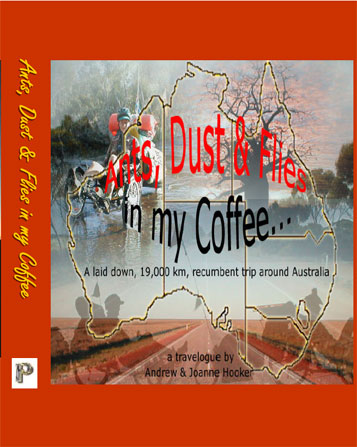
Our Equipment
Quick Links to information on our:
Equipment as anyone knows, is a vital part of the success or failure of any adventure, and ours is no different. A quick check of our existing gear showed us that some of it was in need of repair or replacement.
We started by thinking about the trip and the conditions we expected to encounter - obviously the North American conditions were going to be different to those we experienced here in Australia on our last trip. So with that in mind we decided to minimise our load, obtain only the things we needed to replace to get us across to Melbourne and to then buy the rest in Canada or the USA. The reason for this was two-fold; to reduce airline baggage weight, and to buy equipment made for the climate and conditions in the country we were going to be in.
Being members of the West Australian Human Powered Vehicles (WAHPV) we naturally chose to buy our trikes from a fellow member and local manufacturer Martin Arnold, owner of LoGo Trikes.
We took our trikes around Australia from November 01 to September 03, and had no issues with them except for a few non-LoGo components. Being very early models (# 007 and 011) our trikes do not really resemble the beautifully crafted models of today, but they are still LoGo's and perform very well.
During our time between trips we modified the trikes slightly by changing from drum to disc brakes, and we re-painted and replaced components on Joanne's trike, but that is about all we have done with them, other than over 27,000 kilometres (as at Jan 07) of enjoyable riding.
Like most recumbent riders, we have named our trikes. Joanne's trike has the serial number of 007 and is therefore named - James. Andrew's trike has the serial number of 11 and is named after the paint scheme - Watermelon Red and as such is named Pip.
Loaded in North America and ready for the road, they look like this -
James
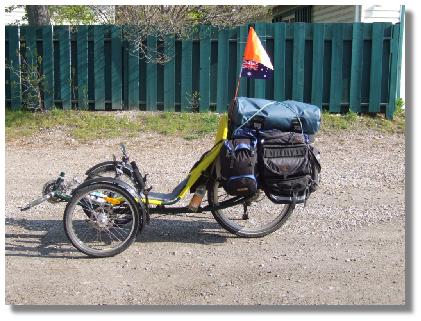
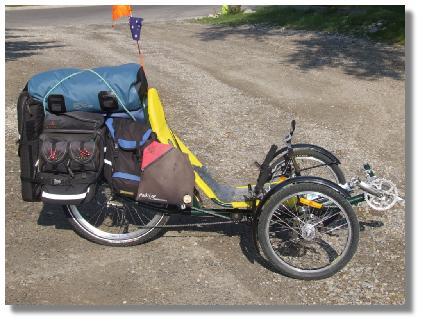
Pip
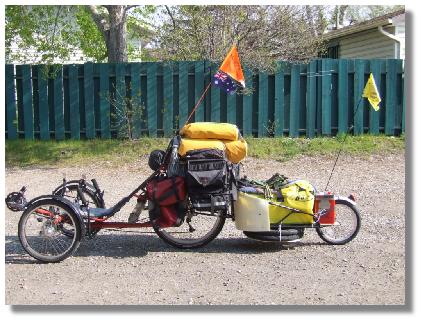
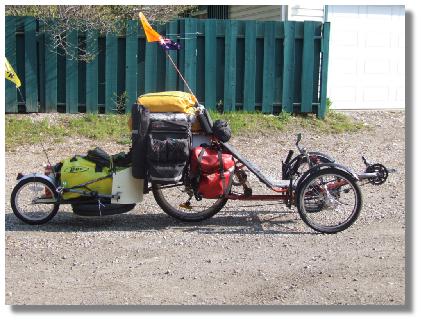
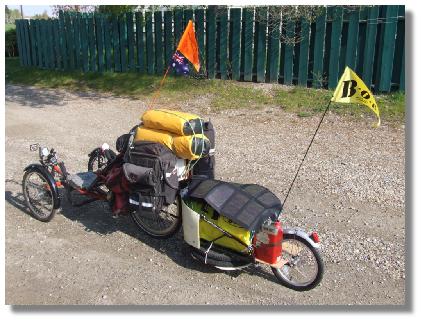
So how are the trikes configured? James is made of mild steel and Pip is made of Chro-moly.
| Bottom Bracket | Sealed |
| Chain-rings | Shimano Deore Cranks with triple chain-rings (22, 32 and 44) |
| Pedals | Wellgo M17 |
| Rear De-railiers | Shimano Deore XT |
| Gears (cluster) | Shimano 7 speed 34-11 |
| Brakes | Shimano cable operated Discs |
| Front Wheels | 20" DM18's AlexRim |
| Front Tires | Maxxis Hookworms |
| Front Hubs | Bitex |
| Rear Wheel | 26"Kinlin MX2G rim |
| Rear Tyre | Schwalbe Marathon XR Plus |
| Rear Hub | Bitex |
We started our equipment replacement programme with new panniers. Our
old Tioga panniers had done us proud, but we felt they would not stand
up to the rigours of the next trip. So after much research, including
seeing some in actual use, we settled on some Arkel GT54's, which look
like this.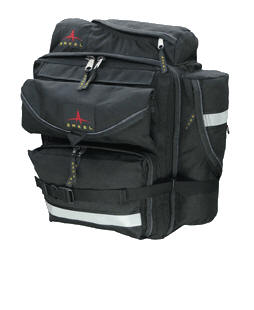
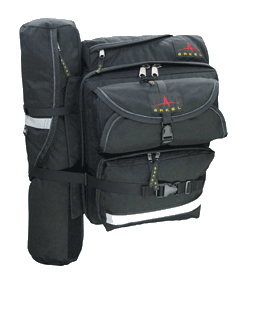
For those left wondering what the large sausage like thing on the left is - that holds the rolled up self inflating mattress. The short one on the right holds the fuel bottle for the stove .
TRIP UPDATE: The Arkel GT 54 panniers are good and are doing their job, but we have found the following issues with them:
1. Compared to others on the market they are heavy.
2. The rain covers that come separately are awkward to put on and take off, and not being part of the pannier itself, do not cover the whole pannier. They leave the area next to the wheel exposed and water and dirt can get in.
3. Having to continually tighten the locking mechanism on the back is a pain in the backside but better than the pannier jumping off the rack all the time.
4. We replaced the Arkels with Ortlieb Classics Sept 07
Having
proven themselves on our trip around Australia we decided to also
include our 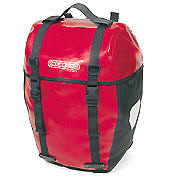 Ortleib's.
These panniers are great because they are virtually waterproof and
despite their looking small, are big enough to hold a sports bag full of
clothes.
Ortleib's.
These panniers are great because they are virtually waterproof and
despite their looking small, are big enough to hold a sports bag full of
clothes.
TRIP UPDATE: These panniers continue to excel and are definately the bees knees. The heavy duty plastic clips have not been affected by the Arctic cold or the rain etc since. We have nothing but praise and admiration for job these panniers have done.
Since arriving in Calgary we have added a couple of bags to our collection. We have obtained a Sealline Zip Duffle bag in which we will house our tent and associated equipment. This bag is waterproof and is normally used in canoes and kayaks.
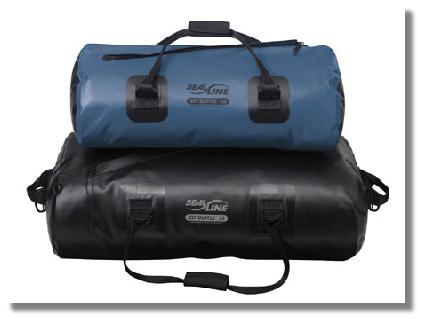
TRIP UPDATE: The SealLine bag is briliant and has is handling the trip with ease. Well worth the cost.
To house our sleeping bag and wet weather clothing we have bought a couple of yellow 20 litre MEC Dry Sacks (shown in red)
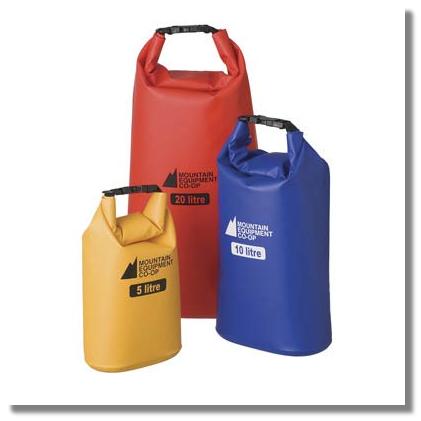
TRIP UPDATE: The MEC 20 litre dry sacks are brilliant and have handled the trip with ease. Once again, well worth the cost.
And what about the Bob trailers? We initially decided not to use them
for our North
 American
trip, not because they are a problem, but primarily because we take too
much stuff with us when we have them - because we can! But after packing
the trikes and riding for a bit without a trailer we realised that
carrying enough water on the trikes was going to be an issue, purely
from a weight on the frame and rear wheel perspective. With this in mind
we had one sent to us from our storage unit. Since then it has performed
as expected and beyond.
American
trip, not because they are a problem, but primarily because we take too
much stuff with us when we have them - because we can! But after packing
the trikes and riding for a bit without a trailer we realised that
carrying enough water on the trikes was going to be an issue, purely
from a weight on the frame and rear wheel perspective. With this in mind
we had one sent to us from our storage unit. Since then it has performed
as expected and beyond.
NORTH AMERICAN UPDATE.
After leaving our Bob trailer behind in Melbourne (to save weight when flying) we obtained a new one in Calgary.
TRIP UPDATE: As expected, the Bob has performed well and truly above expectation.
We
are going with the Maxxis Hookworms for the front wheels. The Hookworms
gave us
 fabulous
mileage (9,000 km to a set) and stability on our circumnavigation of
Australia so we do not intend to change them.
fabulous
mileage (9,000 km to a set) and stability on our circumnavigation of
Australia so we do not intend to change them.
The Hookworms well very well and give good grip without sacrificing too much speed through rolling resistance.
The rear tire however, is a concern not only because it is the drive
wheel, but also
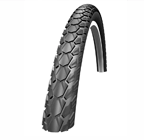 because
it carries so much weight. So after hearing so much about the Schwalbe
Marathon XR's we decided to give them a go.
because
it carries so much weight. So after hearing so much about the Schwalbe
Marathon XR's we decided to give them a go.
Schwalbe have kindly agreed to sponsor us for tyres while we are in North America. Going on the the excellent performance of our Schwalbe Marathon XR's to date, they will not have to provide us with much, but we are excited about having them onboard. So next time you need a good bike tyre, think Schwalbe.
TRIP UPDATE: The maxxis and schwalbetires have been outstanding on this trip. We expected some issues with them on the Dalton Highway, and were pleasantly surprised when we didn't. From start to finish on this trip we replaced all of our tyres once, and we are still on the same second set. They have taken a real battering on this trip and have performed like no other. These tires are Number 1. In our opinion, if you go touring on anything other than these then you are asking for trouble!
Water was a high priority as we crossed Australia and parts of the USA (Mojave Desert), so following the
success of using them on our round Australia trip we used the
Sea to
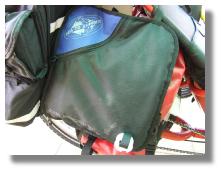 Summit
6 litre water bags. They allow us to carry plenty of water in a safe and
convenient way. We will each carry at least two of these (12 litres = 12kg)
thereby giving us 3-4 days travel time before we require a top up.
Summit
6 litre water bags. They allow us to carry plenty of water in a safe and
convenient way. We will each carry at least two of these (12 litres = 12kg)
thereby giving us 3-4 days travel time before we require a top up.
As you can see in the picture, the straps sling across the seat nicely and the bags hang off the side of the trike, or anywhere else we might choose to put them. They have a wine bladder insert and rubber spout that allows us easy access to fill or empty them. And of course if you need a replacement bladder you can always drink the wine, rinse the bladder and re-fill with water.
TRIP UPDATE: These bags again performed exceptionally well on the trip. The inner bladders did deteriorate and one was rendered non usable. The water didn't freeze during our coldest times, but was close to it. We still recommend using these bags but would suggest that spare bladders be obtained or available along the way.
Obtaining water in North America was easier than in Australia and as such we didn't have to carry as much water on the trikes - all the time. In order to pick up water out of streams, rivers, puddles and the like we used an MSR water filter. According to the makers, this unit can produce 1 litre per minute via the easy to use handle and with its ceramic filter, will protect us from most of the nasties.
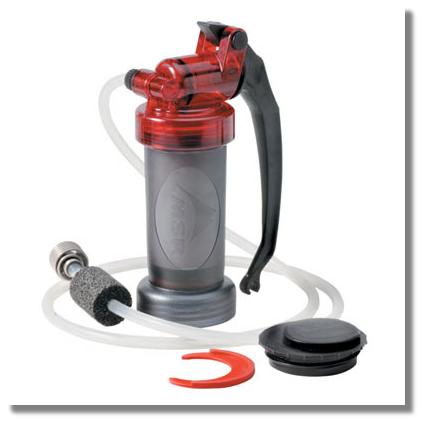
TRIP UPDATE: This unit has been easy to operate as long as the filter is cleaned with the small scouring pad before use. In hindsight, we could have had a smaller unit but that is our only issue with this unit. It has performed extremely well.
Seeing that this trip was going to involve hills and mountains, I toyed with the idea of an altimeter. Unfortunately it was another piece of kit that on itsown was not really practical but would have been nice to have.
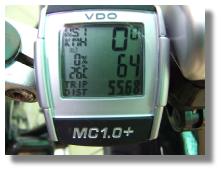 So
in doing some research I was able to find a bike computer that
incorporated not only the usual bike computer functions, but also had an
altimeter; thermometer; and gradient register. It is a wireless unit so
it will be interesting to see how is goes, and how much, if any,
interference it gets from powerlines and the like.
So
in doing some research I was able to find a bike computer that
incorporated not only the usual bike computer functions, but also had an
altimeter; thermometer; and gradient register. It is a wireless unit so
it will be interesting to see how is goes, and how much, if any,
interference it gets from powerlines and the like.
Trip Update: The VDO has worked extremely well and has not suffered from electrical or metalic interference, the mounting however has suffered and the rubber backing area broke away from the actual mount. This issue was rectified by use of a bandit clamp and two cable ties.
We obtained a new wireless cycle computer for Joanne in Calgary but it and its replacement continually stoped working after only a few thousand kilometres and wended up transferring the VDO MC1.0+ to her trike and using the GPS on mine.
As anyone knows, there are as many tents
on the market as there are people wanting one.
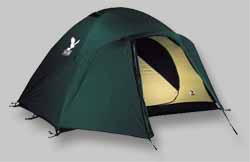 On
our trip around Australia we ended up using three tents, mainly because
the sun and UV wrecks them, and the daily use of zips which ended up
their failing, in part because of the dirt and grit that gets into them.
On
our trip around Australia we ended up using three tents, mainly because
the sun and UV wrecks them, and the daily use of zips which ended up
their failing, in part because of the dirt and grit that gets into them.
Our current tent is the last of those three, a Salewa Magnum. Unfortunately for us, it is more suited to the cooler climes and can be rather hot in warm weather.
Because we had eaten and stored food in our tent while in Australia thereby possibly turning it into a bear attraction, and to help save weight on the plane, we decided to obtain a new tent in North America. We settled on the MEC (Mountain Equipment Coop) North Wind as shown here. This is a four season tent with many great features which we will catalogue in our journal pages.
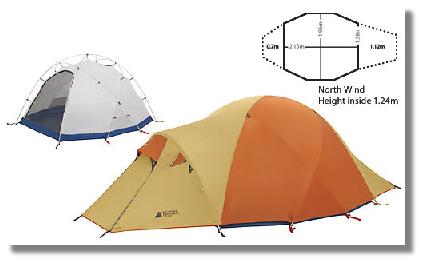
TRIP UPDATE: This tent has been brilliant except that we are continually breaking poles (see picture below).
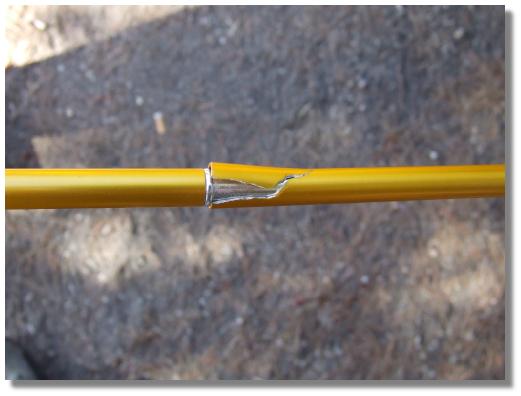
The poles develop hairline cracks and then break for no apparent reason. We have replaced them but the replacements also broke. We have now reluctantly returned the tent to MEC and bought a new one, a Mountain Hardware Trango 3.1 from REI. See below.
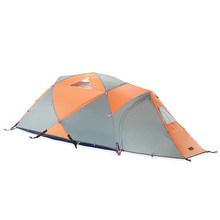
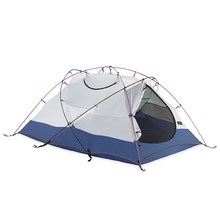
This tent has proved to be an excellent tent, with only a few things that we have found we don't like. The doors are in a "D" shape which means that the person sleeping on the opening side gets cold because the door is open, it would be better if the D was on its side like the North Wind; the colour is not that great as far as remaining hidden when camping next to the road, but is excellent safety wise; the hooks that hold the tent tight to the frame continually get caught on things when packing it up and are a source of frustration; and the biggest bug bear - the fly screen is on the inside meaning you have to open it to open or close the doors, and would be better the opposite way round. Other than that, it's a great tent.
Our next item on the replacement list was our self inflating mattresses. Now, our Great Outdoors ones that had given us plenty of comfort and good sleeps around Australia were just a tad too big for our liking, not to mention they wouldn't fit into the mattress holder on our panniers, so, after much research we settled on the regular sized Thermarest. The interesting thing about this mattress is that initially it felt too narrow, and certainly not thick enough to provide comfort, but that initial impression soon changed and we have enjoyed many nights of comfortable sleep on these mattresses.
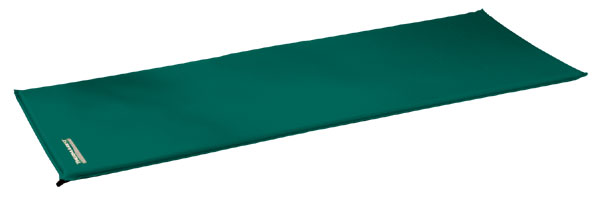
TRIP UPDATE: These sleeping mats worked out very well. Totally recommended.
Sleeping Bag
Our old down filled sleeping bags were just a
little old and not quite as warm as they should 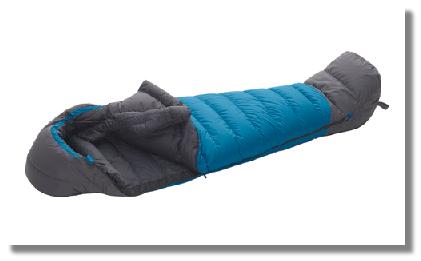 be, so we not only obtained a new one, but a new way of using it.
be, so we not only obtained a new one, but a new way of using it.
Our new bag is down filled, has a waterproofing area around the foot and head and is rated to -12 deg C.
The new way of using it is opened out and used as a doona cover across the pair of us rather than a bag top and bottom and zipped together to make a double bag.
We were introduced to this method by our Canadian friends, and since trying it out have adopted it as a better way of sleeping. Of course the real test will come in Alaska and we will let you know how it goes in our journal pages.
TRIP UPDATE: This bag worked fine but the narrow foot section caused us to send it back to Calgary and to obtain a new one with a more square foot end. Both bags have been fine and other than the foot area issue mentioned, we think they are great, as has the new method of using them.
Our stove was the next item for upgrade, and not wanting to get rid of
the Trangia that had provided us with good meals on our circumnavigation
of Australia, we decided to just upgrade the burner from the mentholated
spirits burner to a multi-fuel burner as shown here.
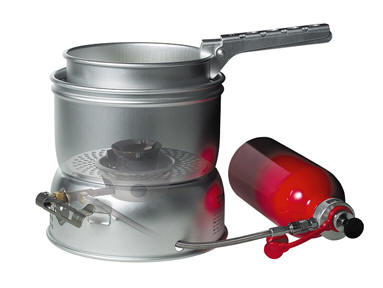 So
rather than having to rely on finding mentholated spirits, we can cook
on almost any type of fuel.
So
rather than having to rely on finding mentholated spirits, we can cook
on almost any type of fuel.
The added bonus is that if we accidentally tip it over, we are not likely to spill the fuel everywhere and burn the place down, though care will still be required.
Along with the multi-fuel burner, we obtained a fabulous invention
called a "Multi-Disc"
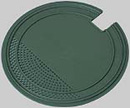 which among other things acts as a chopping block, colander and stove
platform in the snow.
which among other things acts as a chopping block, colander and stove
platform in the snow.
TRIP UPDATE: The Trangia performed extremely well but we returned it to Calgary and bought an MSR Whisperlite in Fairbanks as part of an overall weight reduction process. We should stress that we have absolutely no issues with the Trangia other than the fact that it is slightly heavy. The MSR Whisperlite is extremely lightweight but does not have the control over the heat that the Trangia does.
TRIP UPDATE #2: The multip-fuel burner has broken. The base of the unit is cast brass and has a threaded pin to hold it to the rest of the unit, and it is this part that has sheered off. Temporary repairs were made to it but they failed only a week or so later.
Being a person who likes gadgets and things, electrical items are in the list of equipment. Being electrically self sufficient is a wonderful thing and certainly adds to the enjoyment of cycle touring and camping away from mainstream accommodation.
During our around Australia trip we invested in a solar power plant which recharged the mobile phone, UHF radio's, camera batteries and of course the laptop, and we have continued the solar power idea on our 3 oceans on 3 wheels trip.
Our Australian solar power plant consists of a 20watt glass surfaced panel which sits on top of a plastic container holding the other components. Inside the plastic container is a 12v 7amp sealed gel cell battery (heavy!) connected to a regulator and an automotive cigarette lighter. For 240v power there is also a 130watt inverter.
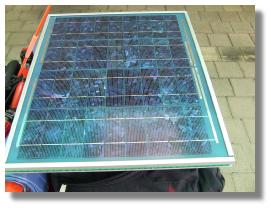 The Panel |
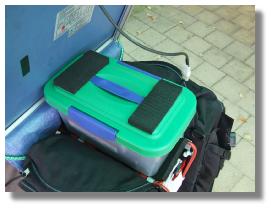 The Container |
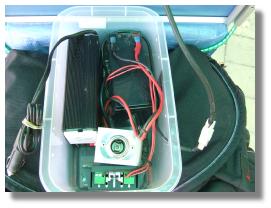 The workings |
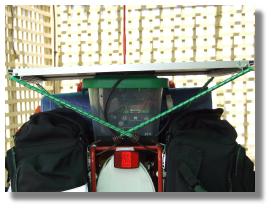 In situ on the trike |
Not wanting to take this unit to North America because of the weight issue, we bought a new panel and battery. So with these new items our North American solar power plant consists of a folding 12watt panel (complete with all the necessary cords) our original battery connectors, cables and socket, and a new 12v 7.2aHr Gell-Cell battery for bulk storage.
During our solar power research phase we found solar panels hard to obtain in Canada as they are somewhat of a novelty. We were however given great advice and service from Graham at The Modern Outpost in Courtenay, British Columbia.
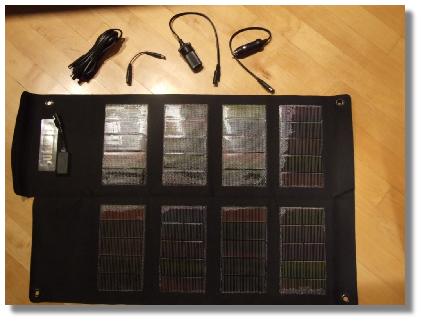
Folded it looks like this (about the size of a paperback book)
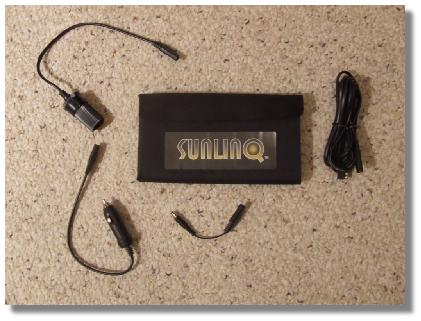
and in situ, it looks like this
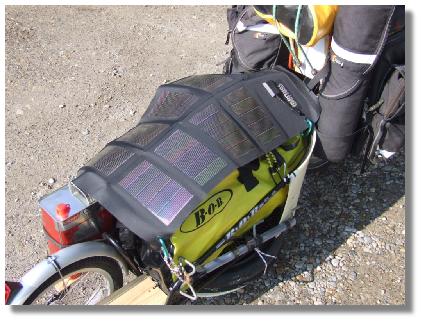
To boost efficiency and to save some more weight, we decided to totally remove the inverter from our electrical system, as such it is now a totally DC system.
We have an adjustable DC connector which allows us to run equipment such as the rechargeable battery charger and if need be the camera, straight off of the panel and battery rather than using the inverter.
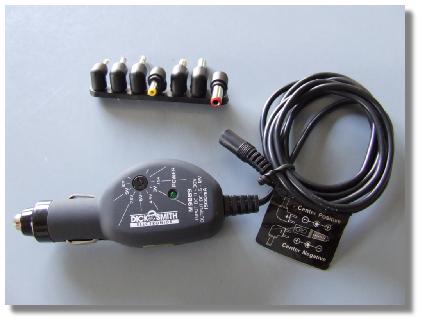
and the laptop will run off of the auto/air adapter regardless of where it is plugged into - vehicle, aircraft seat socket or our solar power plant.
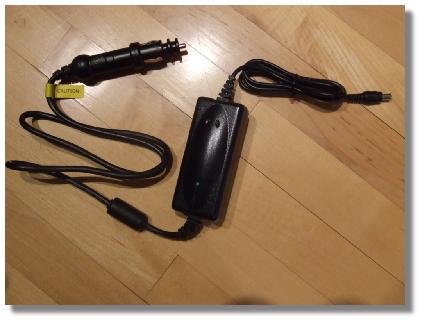
TRIP UPDATE: Our electrical setup has not performed as anticipated and other than a lack of sunny days we are not sure why. The 12v 7.2aHR battery seems to drain very quickly and the 12w flexiblepanel seems to take all day to recharge it. We are not sure what to do about this issue so will continue as is until we can figure out a better option. There is plenty of daylight but it appears that it is not very good for solar power production.
TRIP UPDATE #2
Our panel was defective and returned to the manafacturer. The new one works perfectly well. All is well in this department.
As far as using this type of system to provide power is concerned, if you are touring in a place or style that allows regular AC connection, we would recomend saving weight and not using this type of system.
In Australia we use a Telstra CDMA mobile phone because it gives us the best coverage around the country, has no gimmicks (ours doesn't) or boundaries of use. Overseas however, will be a different story. Because we will have to pay for the International component of any call received we will not be using the Telstra phone and will just use Skype or buy a pre-paid local phone card.
During the Australia leg of our 3
oceans on 3 wheels trip we used the Telstra 3G PCMCA card.
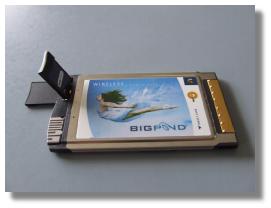 This
meant that wherever we had a phone signal, including CDMA, we had fast,
wireless Internet access.
This
meant that wherever we had a phone signal, including CDMA, we had fast,
wireless Internet access.
Overseas however was another matter as the Bigpond charges (because of the International use) are too much to continue to use this method.
The story in North America is totally different and it appears that the same system is available but at a hugely increased cost (and you thought Telstra was bad!) Therefore, until we can find a system at a reasonable price we will be using free Wi-fi where we can find it andthe mail2web Internet system. This will limit our communications ability somewhat but it is the best we have found at the time of writing.
We should let you know that we get paid by them should you click on the link and /or obtain their services through our link.
TRIP UPDATE: Mail2Web has been fine where there has been a connection point. Most of our connections have been through free Wi-fi at campgrounds, motels and the like.
Our website and other computing needs are compiled on our Fujitsu P7010 Lifebook.
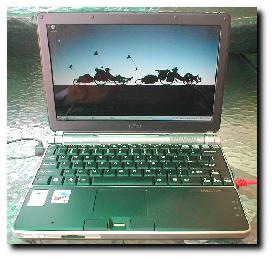
TRIP UPDATE: The Lifebook continues to perform well despite living for most of the time in a pannier on the trike. We have had absolutely no issues with this unit.
Prior to undertaking the 3 oceans on 3 wheels trip we bought a new camera. Following the success of other people with this type we bought a Fuji Fine Pix S5600, and we have not regretted it. The camera has provided us with many good quality photo's and movies.
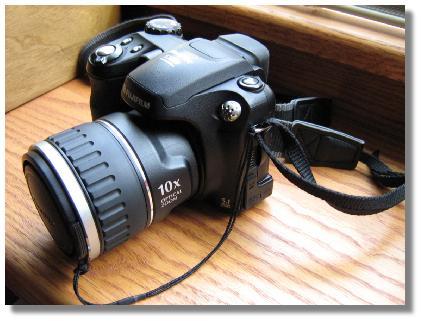 Running on 4 AA batteries, the camera
allows us use our re-chargeable batteries which not only saves us money, but saves
the landfill and ultimately, the environment.
Running on 4 AA batteries, the camera
allows us use our re-chargeable batteries which not only saves us money, but saves
the landfill and ultimately, the environment.
TRIP UPDATE: This camera is an absolute beauty. It has taken a real battering on the trip and still performs well. The addition of a lense filter and wide angle lense have also been worthwhile.
In addition to the camera I emailed clamperpod.com and in the process of ordering these items sought some product by means of sponsorship. What I received in reply was a very nice offer from the owner - Fred.
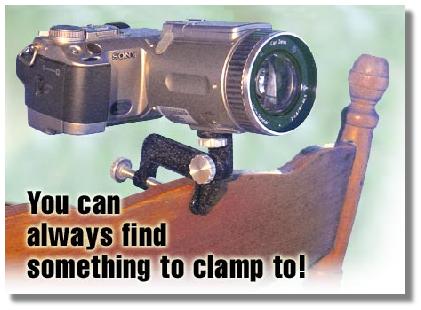 Fred supplied us with a clamperpod and a precision mini ball head, and having received the items when we got to Canada, all I can say is that I wished I had thought of them before Fred.
Fred supplied us with a clamperpod and a precision mini ball head, and having received the items when we got to Canada, all I can say is that I wished I had thought of them before Fred.
Both the clamp and the mini ball head are well made, sturdy, light and compact, ideal for easy use and travel.
Click here to go to his website and see how these items could benefit you. If you do order any of these products, please tell Fred that you heard about them from me, that way he will know his kind and generous offer to provide us with some was worth his while.
As we use these products we'll provide some feedback as to how they went.
TRIP UPDATE: The clamperpod is a fabulous product and has been extremely useful during the trip. Do yourself a favour and get both the clamp and the mini bal head.
We have also bought a small, lightweight telescopic tripod which we used for off the bike or tree and clampable item less environs.
As part of our equipment we have some close quarter anti-bear measures. These items consist of a can of Anti-Bear pepper spray and a pack of Bear bangers. The bear spray isself explanatory and the Bear Bangers, which are launched from a pen launcher, fly up into the air (or wherever you point the thing) and explode, theoretically scaring the bear off and saving use of the pepper spray.
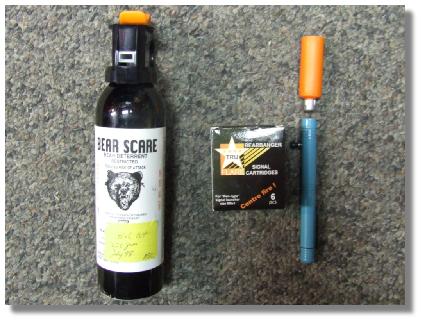
TRIP UPDATE: Not having had to use these items on the trip, we cannot attest to their effectiveness.
Special clothing for Alaska includes a Bug Shirt to keep the thousands of hungry mosquito's at bay as well as good wet weather clothing.
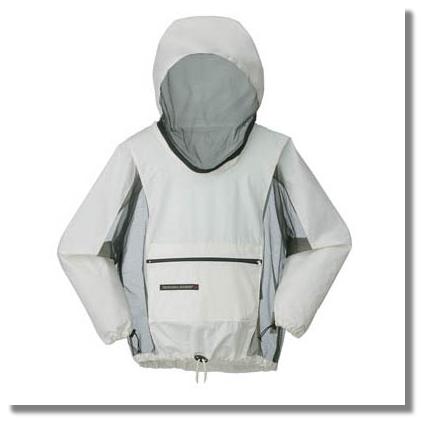
The very fashionable Bug Shirt.
TRIP UPDATE: Keeps the bugs out but can be hot to wear.
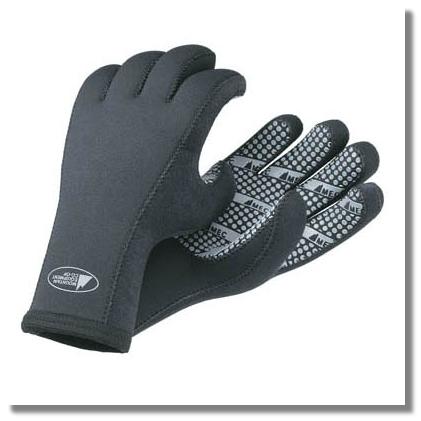
Waterproof Over Gloves
TRIP UPDATE: Great for wet cold rides or warming up after one, but being neoprene, is the same as wearing a wetsuit.
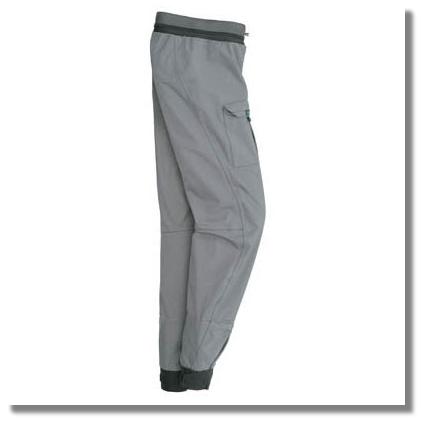
Waterproof Canoeing Pants
TRIP UPDATE: Great wet weather pants! Can get a little warm during the ride and the rubber inside can drag on leg hair. They do not breathe very well but dry extrelmely fast following rain. Mozzies cannot get through them either. Well worth getting.
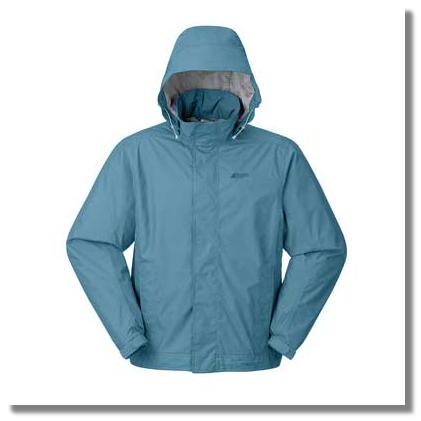
Waterproof Jacket
TRIP UPDATE: A gore-tex type fabric which is good in the rain when all openings are closed up. Jacket tends not to breathe very well, so long periods of wear can result in sweat building up inside and making you wet. Takes some time to dry out. Keeps the wind and mozzies out quite well.
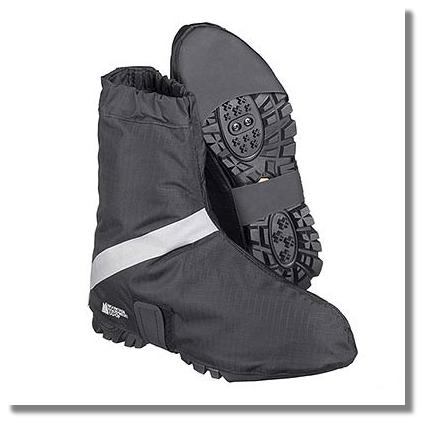
Shoe Covers
TRIP UPDATE: These items are among our favourite. They are fabulous for keeping your feet and ankles dry and warm. They look a little like moon boots but they are fabulous!

Gore-Tex Socks (as used by the US Military)
TRIP UPDATE: We haven't used these yet so cannot comment.
In addition to the above, we used various layers of Icebreaker Merino wool clothing, which, if we were to dress in all of it, it would give us a skin, mid, outer and weather layer (yes, we are expecting some cold and wet weather). The great thing about the wool is that is doesn't hold odour, and even when wet, can provide warmth.
We obtained some great sunglesses complete with inter-changable lenses for all types of light - including snow.
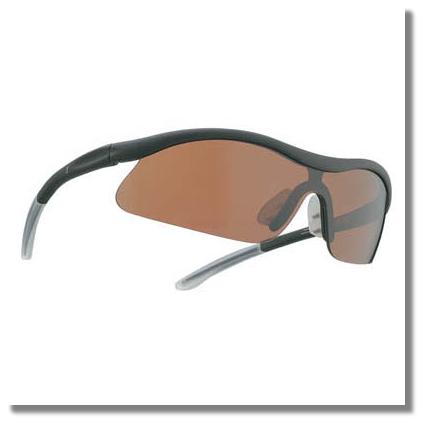
TRIP UPDATE: Great sunnies! Interhcangable lenses make are fabulous and they are great to wear. A good buy from MEC.
So what didn't work as far as equipment?
Most of our gear has lasted and performed well, the following however is a small list of equipment that has failed or broken and the actions we took to rectify the problem.
3 rear wheel spokes on Pip - replaced.
Tent poles split - repaired using pole repair tube before being totally replaced.
Gear lever on James lost the indexing - replaced in Whitehorse.
Shock cord on seat on Pip - repaired by re-tying and re-stringing.
Front wheel tube valve split on James - replaced tube in Dawson City.
Bike Computer mounting on Pip - used bandit clamp and cable ties to hold in place.
Front chainrings and crank after the chainrings came loose at the crank. Not a bad effort considering this part lasted 19,000 km around Australia, 4,000 km across Australia and 800 km down the Dalton Highway. Replaced in Fairbanks Alaska.
Following our trip across Australia and the trip down the Dalton we replaced the chains and rear cluster on both trikes in Fairbanks due to chain stretch and wear.
Replaced the bottom bracket on Pip in Ventura
What did work (recommendations)
And what did work? Well, for starters, the trikes have again performed to our expectations. The only issue we have had has been the seat frame on Joanne's trike which broke during use, probably because the frame was not drained properly after dipping in caustic prior to being repainted. We are sure that this caused some internal corrosion and subsequent failure. The good news however is that following sending the frame back to Martin Arnold (owner of LoGo Trikes) the frame and temporary weld has been fixed.
The Maxxis Hookworms and the Schwalbe Marathon XR tyres after thousands of kilometres, have done an exceptional job. Both types still look new, and have handled the dirt roads very well. We recommend them both, especially the Schwalbe Marathon's which, being on the rear wheel, carrying all the weight and having to flex a lot as we ride, need to be strong and dependable. As of Burns Lake BC we are still on the original set.
The Kinlin MX2g Rims (rear) have again performed exceptionally well, especially considering the weight they are carrying and the fact that they are the drive wheel.
The Clamper-pod works extremely well in many areas and provides an excellent platform for the camera.
Read about our cycling trip around Australia in our book - "Ants, Dust & Flies in my Coffee..."
and our latest...
Triking Alaska's
Dalton Highway
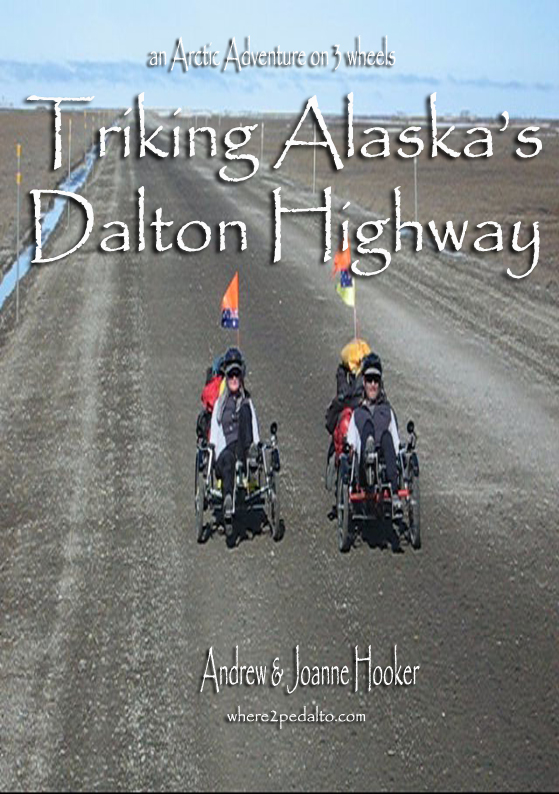
Our Latest Book in
E-Book Format
(requires Adobe Acrobat Reader)

